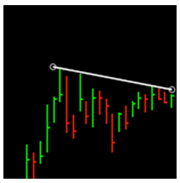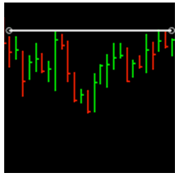Traders can be sure they’re staying on the proper side of the trend by following a few simple rules when price approaches a slanted or flat trend line on the charts.
I take a lot of simple trend line trades because they give me a clear indication that price is either clearing an important level or that it’s making a meaningful turn.
Recently I was asked why some of those trend lines are flat (lateral) and others are tilted. Additionally, I was asked how I determine my entries in each case. Here’s what I said:
Whenever a trend line is slanted (see below), I go with a break of the trend line itself. In the case of a bullish trend line break (a move above a descending trend line), I’ll place a buy stop just above the line itself, perhaps only a couple of pennies above it. These tilted trend lines are themselves the resistance for a stock, so once broken, the stock tends to be free to move higher.
Whenever there’s a flat trend line of support or resistance (see below), it’s evident that price is bumping up against a key zone which remains constant. Sometimes this is at a round number, like $100, but it doesn’t have to be.
The way I trade these flat trend lines is to set a buy stop ten or 15 cents past the resistance zone, as that will help to confirm I’m entering upon a true breakout that’s taking place rather than a brief penetration of only one to five cents, which could prove to be only a head fake.
When you’re drawing your trend lines, consider the overall situation. Is price struggling to clear a constant level? If so, use a flat trend line. If price is simply seeing a countertrend pullback, then the pace of the pullback is better seen with a tilted trend line.
By Jeff White, trader and blogger, TheStockBandit.net




















